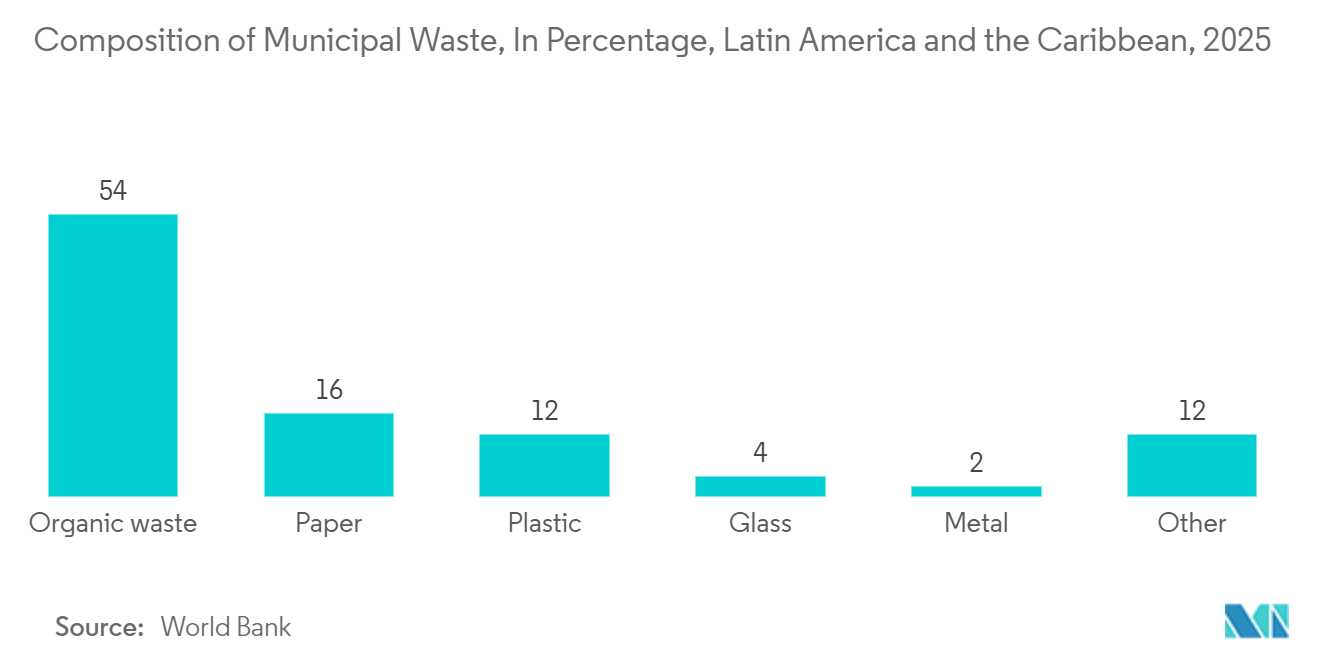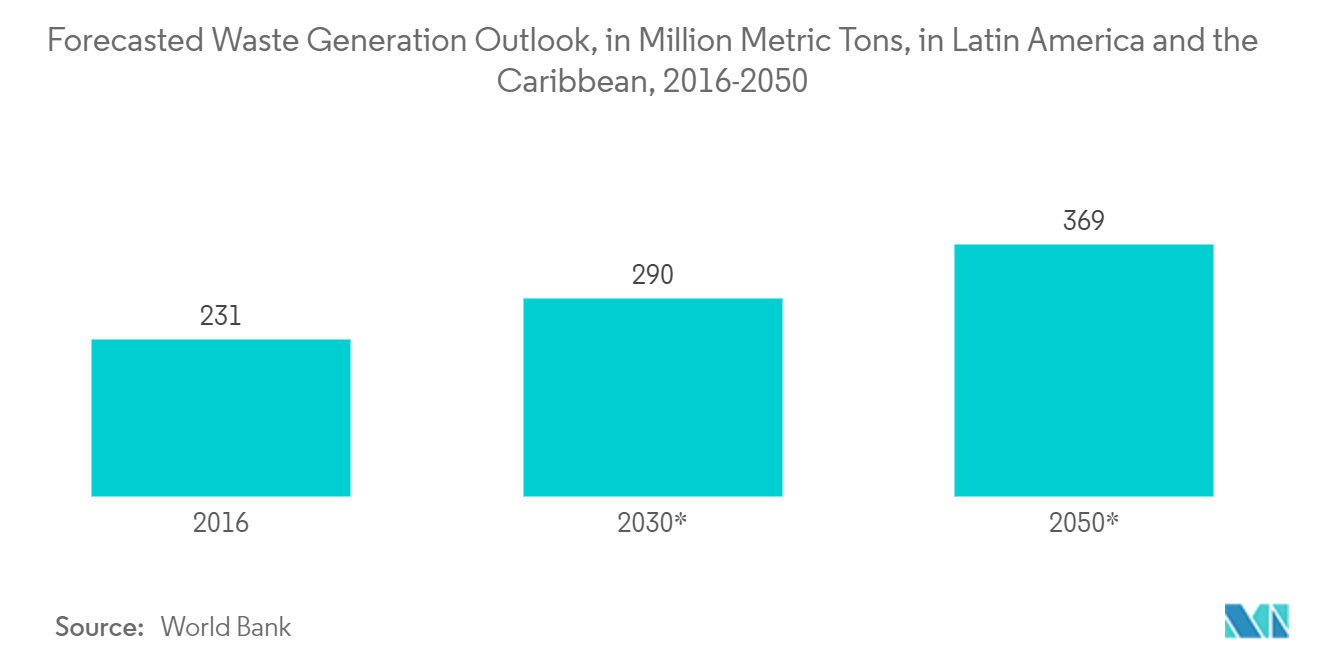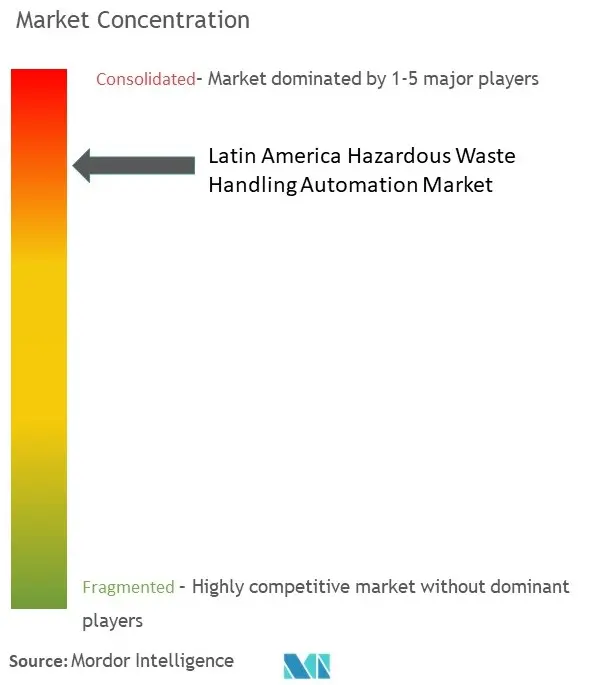
Latin America Hazardous Waste Handling Automation Market Analysis
The Latin America Hazardous Waste Handling Automation Market size is estimated at USD 3.78 billion in 2025, and is expected to reach USD 5.12 billion by 2030, at a CAGR of 6.26% during the forecast period (2025-2030).
- Stringent regulations, both from governments and industries, are fueling the growth of the hazardous waste handling automation market. These regulations aim to safeguard both people and the environment from the dangers posed by hazardous waste.
- Non-governmental and community-based organizations are collaborating with healthcare facilities to enhance medical waste collection, recycling, and disposal. Such collaborations not only address immediate needs but also drive the adoption of automation solutions in waste management.
- Hazardous waste, a byproduct of daily activities in households, power plants, and industries, demands careful handling. Automation solutions not only enhance efficiency but also reduce the risks associated with manual intervention, which is crucial given the potential dangers to human health. As safety concerns mount, the region is witnessing a parallel rise in the demand for automation in waste management.
- Recognizing the public health risks posed by hazardous waste, governments are increasingly focusing on regulations to ensure its effective treatment, recycling, and disposal, thus mitigating environmental pollution.
Latin America Hazardous Waste Handling Automation Market Trends
Growing Concerns About Waste Management Are Expected to Drive the Demand
- Hazardous waste, a byproduct of various industries, poses a significant threat to both the environment and human health. To combat the challenges posed by such waste, the global market for hazardous waste handling automation is witnessing a surge in demand, driven by a growing awareness of environmental issues and changing conditions.
- Within the manufacturing sector, a major contributor to global waste production, a substantial portion of generated waste contains hazardous chemicals. Disposal of these hazardous byproducts, ranging from paints and oils to batteries and reactive substances, demands meticulous attention.
- Improper handling and disposal of these hazardous wastes not only harm the environment but also pose direct risks to human health. This concern, coupled with the escalating waste production in the manufacturing sector, is propelling the market's growth.
- As the risks associated with direct human contact with hazardous waste become more apparent, the demand for automation solutions increases. Automation not only minimizes human exposure but also enhances operational efficiency.
- Effective waste management strategies involve segregating trash at its source, utilizing specialized waste processing facilities for material separation, and investing in waste-to-energy initiatives. These initiatives, including engineered landfill sites and energy generation from landfills through methane extraction or thermal treatments, are bolstering the demand for advanced waste-handling equipment.

Brazil is Expected to Witness Significant Growth
- As urban areas expand, so does the need for efficient waste management. Transitioning trash from smaller to larger trucks at transfer stations enhances collection and transport operations, especially in growing metropolitan areas.
- Garbage collection and transportation costs dominate the city's waste disposal expenses. By enhancing efficiency, cities can cut costs without compromising on service quality.
- The market is abuzz with new product launches, mergers, and acquisitions as vendors scramble to seize the opportunity. Key drivers behind these moves include the relentless adoption of new technologies, unlocking previously untapped commercial potential.
- In Brazil, the IKI project ProteGEEry has been pivotal, aiding 32 municipalities in bolstering their waste management. It also equips local decision-makers and technicians with a toolkit to enhance their capabilities.
- According to the World Bank, global waste generation is on an upward trajectory. In 2016, Latin America and the Caribbean collectively produced 231 million metric tons of waste. Projections indicate this figure could surge to 369 million metric tons by 2050.

Latin America Hazardous Waste Handling Automation Industry Overview
The Latin American hazardous waste handling automation market is consolidated due to the presence of both global players and small and medium-sized enterprises. Some of the major players in the market include PaR Systems Inc., Konecranes PLC, DX Engineering, Floatograph Technologies, and Pallmann. Players in the market are adopting strategies such as partnerships and acquisitions to enhance their product offerings and gain sustainable competitive advantage.
- March 2024: Konecranes launched smart, connected industrial cranes to tap opportunities across multiple customer segments. Identical wireless upgrade capability offers customers more flexibility and provides Konecranes with unique business model opportunities.
- December 2023: In Q3 2023, Eldorado Brasil's new cellulose terminal in Port of Santos received seven forklifts and two gantry cranes from Konecranes. This marked the completion of the order, which also included joint planning and consulting on the layout of the terminal to ensure Eldorado gets the best business return for its significant investment.
Latin America Hazardous Waste Handling Automation Market Leaders
-
PaR Systems Inc.
-
Konecranes PLC
-
DX Engineering
-
Floatograph Technologies
-
Pallmann
- *Disclaimer: Major Players sorted in no particular order

Latin America Hazardous Waste Handling Automation Market News
- April 2024: Clean Harbors Inc., one of the leading providers of environmental and industrial services, introduced its "Total PFAS Solution" to address all the needs of consumers related to PFAS (per- and poly-fluorinated alkyl substances), which are commonly referred to as forever chemicals. Clean Harbors' Total PFAS Solution is the initiative's foremost and only one-stop shop, consisting of eight core elements that offer customers a range of services from analysis to remediation to disposal.
- March 2024: The primary offerings of Clean Harbors Inc. are provided to more than 2,000 customers, including field services, environmental remediation, and emergency response services. It announced the completion of its acquisition of HEPACO, one of the leading environmental providers of field and emergency response services.
Latin America Hazardous Waste Handling Automation Industry Segmentation
Hazardous waste management is the collection, disposal, and treatment of harmful materials. If improperly handled, it can cause substantial harm to human health and the environment. Some of these wastes can be handled manually, while some may require expertise and automation solutions to minimize human contact with the waste.
The study analyzes the adoption of various products, such as manipulator arms, telescoping masts, cranes, trusses, and size reduction systems, to handle several types of waste, such as listed, characteristic, universal, and mixed waste.
The study also analyzes the applications of these products across various end-user industries, such as manufacturing, chemical, energy, consumer care, and government. The study comprises a brief analysis of the impact of COVID-19 on the market.
The Latin American hazardous waste handling automation market is segmented by type of waste (listed wastes, characteristic wastes, universal wastes, and mixed wastes), product (manipulator arms, telescoping masts, cranes, trusses, size reduction systems, and other products), end-user industry (manufacturing, chemical, energy, consumer care, government, and other end-user industries), and country (Brazil, Mexico, Argentina, and the Rest of Latin America). The market sizes and forecasts are provided in terms of value (USD) for all the above segments.
| By Type of Waste | Listed Wastes |
| Characteristic Wastes | |
| Universal Wastes | |
| Mixed Wastes | |
| By Product | Manipulator Arms |
| Telescoping Masts | |
| Cranes | |
| Trusses | |
| Size Reduction Systems | |
| Other Products | |
| By End-user Industry | Manufacturing |
| Chemical | |
| Energy | |
| Consumer Care | |
| Government | |
| Other End-user Industries | |
| By Country*** | Brazil |
| Mexico | |
| Argentina |
Latin America Hazardous Waste Handling Automation Market Research Faqs
How big is the Latin America Hazardous Waste Handling Automation Market?
The Latin America Hazardous Waste Handling Automation Market size is expected to reach USD 3.78 billion in 2025 and grow at a CAGR of 6.26% to reach USD 5.12 billion by 2030.
What is the current Latin America Hazardous Waste Handling Automation Market size?
In 2025, the Latin America Hazardous Waste Handling Automation Market size is expected to reach USD 3.78 billion.
Who are the key players in Latin America Hazardous Waste Handling Automation Market?
PaR Systems Inc., Konecranes PLC, DX Engineering, Floatograph Technologies and Pallmann are the major companies operating in the Latin America Hazardous Waste Handling Automation Market.
What years does this Latin America Hazardous Waste Handling Automation Market cover, and what was the market size in 2024?
In 2024, the Latin America Hazardous Waste Handling Automation Market size was estimated at USD 3.54 billion. The report covers the Latin America Hazardous Waste Handling Automation Market historical market size for years: 2019, 2020, 2021, 2022, 2023 and 2024. The report also forecasts the Latin America Hazardous Waste Handling Automation Market size for years: 2025, 2026, 2027, 2028, 2029 and 2030.
Our Best Selling Reports
Latin America Hazardous Waste Handling Automation Industry Report
Statistics for the 2025 Latin America Hazardous Waste Handling Automation market share, size and revenue growth rate, created by Mordor Intelligence™ Industry Reports. Latin America Hazardous Waste Handling Automation analysis includes a market forecast outlook for 2025 to 2030 and historical overview. Get a sample of this industry analysis as a free report PDF download.



